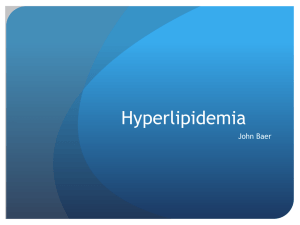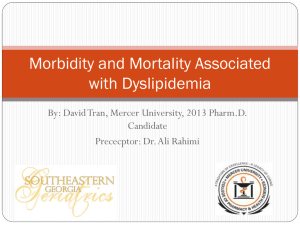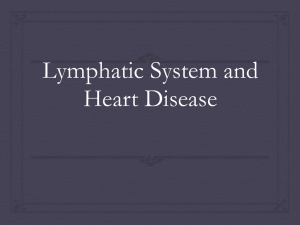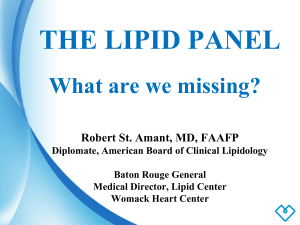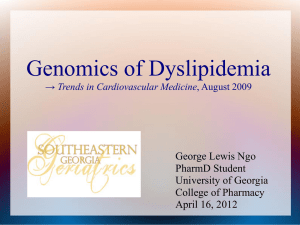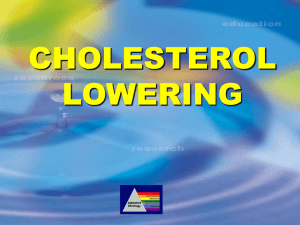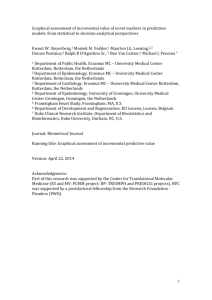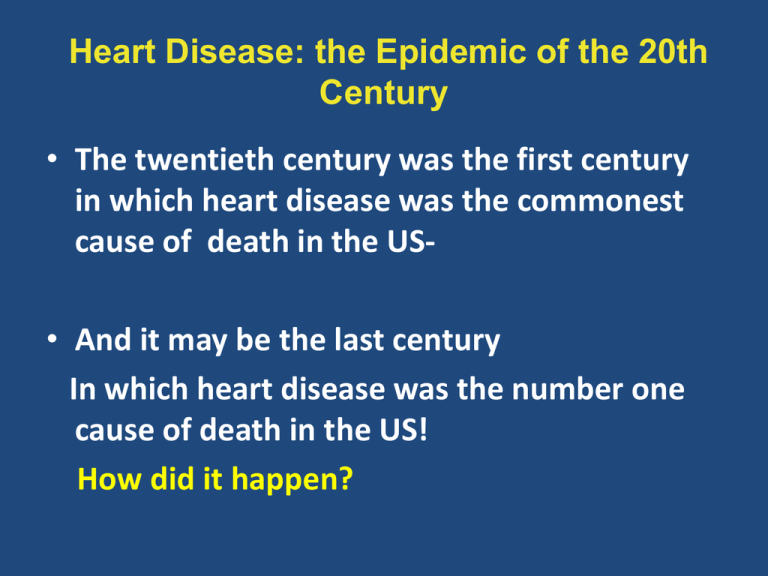
Heart Disease: the Epidemic of the 20th
Century
• The twentieth century was the first century
in which heart disease was the commonest
cause of death in the US• And it may be the last century
In which heart disease was the number one
cause of death in the US!
How did it happen?
US HEART DISEASE DEATHS/100,000
1900- 1950
115% INCREASE
What Caused the Marked Increase in Heart
Disease Deaths from 1900 to the 1960s?
• Americans were living longer due to
decreased death from infectious disease and:
– Introduction of cigarettes
– Changes in the US daily diet
– Decreased physical activity
US HEART DISEASE DEATHS/100,000
1960-2005
63% DECREASE
Heart Disease
the Epidemic of the 20th Century
• From 1960 until 2005 US heart disease deaths
decreased by 63%
• Cancer deaths decreased by 5%
The Marked Decrease in Heart Disease Deaths
since 1965- How Did it Happen?
• Most heart disease deaths are due to
coronary heart disease which was rare in
1900, became the commonest cause of death
in the 50’s, peaked in the 60’s, and has
continued to decline since the mid 60’s
The Marked Decline in CHD Deaths 1965-
How did it happen?
• Research- clarified the pathophysiology of
CHD
Which led to:
• Prevention
• Early, accurate diagnosis
• Effective therapy
Prevention of CHD
The Identification of Risk Factors
• Risk factor: a personal characteristic
(including test findings) that predicts an
increased probability of a future disease or
condition
• Eg: cigarette smoking predicts an increased
probability of lung cancer in the future
Prevalence of Coronary Heart Disease by Age
and Sex in the U.S. (1988-94)
20%
15%
Male
10%
Female
5%
0%
25-44
45-54
55-64 65-74
75+
Age, years
Source: National Health and Nutrition Examination Survey
The Ideal Risk Factor
• 1. Associated with a common, serious
disease
• 2. A frequent finding
• 3. Easily determined
• 4. Reversible or treatable
• 5. If reversed or treated, the disease is
prevented
Prevention of CHD
the Identification of Risk Factors
• Framingham heart study 1948• The Seven countries study 1958-70
• The Interheart study
1999-2004
The Framingham Study
1948• Prospective cohort study began in 1948
• Citizens in Framingham, Mass were invited to have
a free PE, history,CXR, EKG and lab tests
• Subjects were re-evaluated every two years. They
were not treated; This was not a clinical trial
• Personal characteristics of those who developed
CHD or stroke during F/U were
• compared to those who remained well
The Framingham Study 1948Identification of CHD Risk Factors
•
•
•
•
•
•
•
Advanced age
Male sex
Diabetes
Elevated cholesterol
Hypertension
Cigarette smoking
Physical inactivity
Seven Countries Study
1958-1970
• The link between diet, serum cholesterol and
coronary artery disease
Seven Countries Study
1958-1970
Prospective cohort study of 11,575 healthy
men in seven countries.
They found that the following varied
considerably among the countries:
• Diet: esp the amount of sat. fat
• Serum cholesterol levels
• Death rates due to CHD
Seven Countries Study
Findings
• As % of saturated fat in each country’s diet
increased, the average cholesterol increased
• As the average serum cholesterol increased
the death rate due to coronary heart disease
increased
Seven Countries Study
1958-1970
• Lowest cholesterol levels and lowest
incidence of coronary artery disease in
countries with a “Mediterranean diet”
– Low in animal products and sat. fat
– Principal fat = olive oil (mono sat)
– Rich in legumes, fruit, fish
Risk Factors for CHD
a World-wide View
• The Interheart study 1999-2004*
• A global study of CHD in 52 countries in Asia,
Europe, Middle East, Africa, Australia, North
and S America
•
*Yusuf: Lancet,2004
The Interheart Study*
• Case- control study
• 15,000 patients with first MI
• Compared to 15,000 age, sex matched
healthy controls
•
Yusuf: Lancet, 2004
The Interheart Study*
• Risk factor
RR AMI
•
•
•
•
•
3.3
2.9
2.4
1.9
1.6
Increased lipids
Current smoker
Diabetes
Hypertension
Abdom. Obesity
Yusuf: Lancet,2004
The Interheart Study*
Current smoking, diabetes, hypertension and
increased lipids accounted for 75% of the cases of
myocardial infarction
RR with all 4 risk factors = 42
* Yusuf: lancet,2004
The Interheart Study*
•
•
•
•
Results consistent:
Men and women
Old and young
Different countries and continents
Different ethnic groups
Risk Factors for Coronary Heart Disease
• Reversible
•
•
•
•
•
•
•
Increased LDL
Decreased HDL
Cigarette Smoking
Hypertension
Estrogen, OCA
Physical Inactivity
Abdominal obesity
Irreversible
Advanced age
Male sex
Positive family Hx
Diabetes
Type A (?)
Stress (???)
First Attempt at Primary Prevention ?
“Walking is man’s best medicine”
Hippocrates 460BC-377BC
Cholesterol: LDL vs HDL
LDL Cholesterol
– Increased LDL levels Lead to Increased
atherosclerotic plaque
HDL Cholesterol
Increased HDL levels are associated with a
lower incidence of cardiovascular disease
LDL Cholesterol Treatment Guidelines
• National Cholesterol Education Program III
Recommendations, 2003
• Patient
Goal LDL
Drug RX
• CHD or Equiv
<100
>130
• 2+ Risk Factors
<130
130-160
• 0-1 Risk Factors
<160
190
Dietary intervention to Lower Cholesterol
MRFIT 1973-81
• Men and their wives attended weekly small
group sessions. Dietary advice by
nutritionists, supplemented by cardiologists,
psychologists.
• Used food models, sample menus
• Results at 6 years: special care 7.2%
reduction, usual care 5.2%
LDL Cholesterol Lowering Drugs-Statins
• Decrease production of cholesterol by the
liver, and increase removal of LDL
• Serious side effects:
– Liver damage: rare
– Muscle damage: very rare
Hypertension Treatment Guidelines*
• Normal BP
<120/80
• Pre-Hypertension 120-139/80-89
• Hypertension
>140/90
• *Joint National Committee on Prevention, Detection. And Treatment of
High Blood Pressure (JNC VII, 2003)
Prevalence of Hypertension (SBP>140 or
DBP >90) by Age*
•
•
•
•
•
•
•
AGE
20-34
35-44
45-54
55-64
65-74
75+
PREVALENCE
10%
20%
36%
55%
67%
70%
*American Heart Association statistics, 2009
Hypertension in US Adults (>18)
1988 -2008*
Year
1988-94
1999-00
2003-04
2007-08
% HBP**
24%
29%
29%
29%
% Controlled***
27%
31%
33%
50%
* Egan: JAMA May 30, 2010
** HBP = systolic> 140 and diastolic >90
***Controlled = systolic,140 and diastolic < 90
Importance of Smoking Cessation
• Patients who survive a myocardial infarction
and who are clinically stable but continue to
smoke have a 6-fold increased risk of dying
during the next 5 years.
What Caused the Decrease in CHD
Deaths in the Late 1960s?
Prevention
– Smoking: Surgeon General’s report
– Diet: recognition of cholesterol as a risk
factor
– Hypertension: introduction of effective
drugs
Healthy life style
1988 vs 2006*
•
•
•
•
•
US adults ages 40 to 74
1988 2006
Obese
28% 36%
Smokers
27% 26%
Regular Exercise
53% 43%
Healthy Diet
42% 26%
* King: Am J Med, 2009
The Interheart Study*
• Negative risk factors RR AMI**
• Daily fruits/vegs
• Physical activity
• Alcohol
•
* Yusuf: lancet,2004
** Adjusted relative risk
.7
.9
.9
LDL Cholesterol
• Approximately 50% of Adult Americans
Have High LDL Cholesterol Levels –
Over 100 Million People
•
High LDL cholesterol is almost always
associated with cardiovascular disease
American Heart Association: Heart Disease and Stroke Statistics, 2006
Aspirin to Prevent Heart Attack and
Stroke
• Who Should Take Aspirin?
• In the Absence of Contraindications:
– Patients With Known Cardiovascular
Disease
– Adults with Diabetes
– Those with Cardiovascular Risk Factors
– Men age 50+
– Women post Menopause
Low HDL Cholesterol*
• Levels Below 40 in Men and Below 50 in
Women are Associated with Increased Risk of
Death From Cardiovascular Disease.
• Increasing HDL Levels Decreases the Risk of
Cardiovasacular Disease
• Average HDL in Us Adults = 51
*Ashen and Blumenthal NEJM, 2005
Statins in Cardiovascular Disease
10
0
%Risk
-10
Death
MI
-20
-30
-40
-50
-60
UA
Post MI
PTCA
CABG
Primary
12 Trials 186,800 patient-years follow-up
NEJM 1995;333:1301 Lancet 1994;344:1383 Circulation 1995;91:2528
The Multiple Risk Factor Trial
1971-1981*
• Linear relationship between serum cholesterol at baseline and
risk of CHD death during 6 year followup
• Cholesterol
•
<181
–
–
–
–
182-202
203-220
221-244
>245
RR CHD death
1.0
4.7-5.2
5.3-5.7
5.7-6.3
>6.3
* Stamler: JAMA, 2008
Aspirin in Cardiovascular Disease
10
0
Risk (%)
−10
Death
−20
MI
−30
−40
−50
−60
MI
86 studies
670,000 patient-years
Post MI
Unstable
angina
CAD
Primary
Fuster V, et al. Circulation. 1993;87:659-675.
Increasing HDL Levels With Life Style
Changes*
•
•
•
•
•
Regular exercise
Smoking cessation
Weight control
Moderate alcohol consumption
Decreased dietary fat
*Ashen and Blumenthal NEJM , 2005
Aspirin to Prevent Heart Attack and
Stroke
• In 1950, Lawrence Craven reported that one aspirin
a day prevents heart attack in men with CHD risk
factors
• In 1956, he reported that aspirin also prevents
strokes
• No one believed him until the 1970s when
randomized clinical trials proved him right
• Now 50 million Americans take aspirin for
prevention of heart attack and stroke
Aspirin to Prevent Heart Attack and
Stroke
• Major side effect of aspirin is bleeding
• In randomized clinical trials the incidence of
major bleeding is the same for 81 mg/day
and 162 mg/day:
• 1 to 2 cases per 1000 years of treatment
•
Dalen: Am J Med, 2007
Aspirin to Prevent Heart Attack and
Stroke
• Doses less than 162 mg/d may be ineffective
in preventing mi and stroke
• My recommendation: 162 mg/day*
•
*Dalen: Am J Med, 2007
Coronary Heart Disease (CHD), 2006*
• Prevalence
18 million
• Deaths/year
425,000
• 70% of CHD Deaths occur outside of
hospitals
*American Heart Association statistics, 2009


